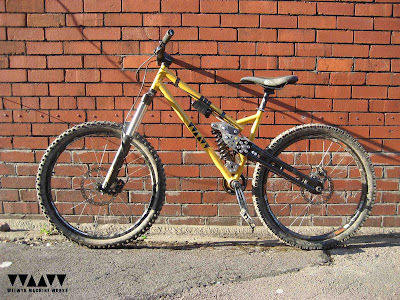Profile Racing disc compatible bmx hub in all it's glory.

Mdf wheel jig, bolts adjusted to position rim on centre line of hub.

Black tape on spoke identifies the 'key spoke'
Lacing up as per the instructions

All spokes laced up

Spokes fully tensioned

The finished wheel.. just needs a frame

As shown in the diagrams in the last post one of the main features of the frame design is that it uses a bmx rear hub with its 110mm dropout spacing to reduce the width of the parallel swing arm design, allowing it fit within the crank arms without fouling them while pedaling. When built the rear wheel will be a bit of an oddball.. 26in mtb rim laced to an 110mm bmx hub.
It took a while finding the right hub as I wanted a bmx hub that was disc compatible and they’re bit of a rarity. Finally I found that Chris King and Profile Racing each make one. The CK one is bloody expensive where as the Profile one was just expensive. I went for the Profile hub with a 14mm bolted axel to provide a really solid connection that should stop the sliding dropouts slipping and help stiffen the swing arm laterally. Luckily when I ordered the hub the exchange rate was pretty favorable.. still got done on the import duty though.. damn!
A mate donated a rim to the cause.. cheers Tony. It was used but still true. The local bike shop worked out the spoke length required for the 26in rim / 110mm hub combo.
If you’re thinking on building your own wheels and haven't done so before check out Sheldon Browns guide:
http://www.sheldonbrown.com/wheelbuild.html , its really informative and takes you through not just how the wheel is built, but the why too.
As I didn't have a wheel building jig and I couldn't use the frame to check alignment I knocked one up out of flat sheet of mdf and some bolts. The bolts allow the rim to be lifted to the centre line of the hub and by flipping the wheel over you can double check alignment.
It took a little longer than the instructions suggested but by following them I was able to build my first wheel with out too many troubles. Its just a case of take your time, don't rush ahead and start tensioning spokes too quickly like I did, and if things start to go wrong go take a timeout.
As far as I can tell the wheel has come out pretty well. I'll probably get one of the local bike shops to check it over before it gets used for real, but I think it should be OK.. in fact it’s in a hell of a lot better condition than all my other wheels!
All I need to do now is build the frame otherwise all I've got is an expensive wheel that doesn't fit anything.. useful!


















 Mdf wheel jig, bolts adjusted to position rim on centre line of hub.
Mdf wheel jig, bolts adjusted to position rim on centre line of hub. Black tape on spoke identifies the 'key spoke'
Black tape on spoke identifies the 'key spoke'


 The finished wheel.. just needs a frame
The finished wheel.. just needs a frame



